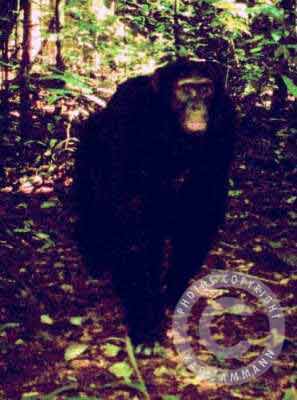Tuesday, February 4, 2014
Post Revamp: the Bili Ape
Today I'm adding a new tag to BeastPedia -- "Confirmed." As you'd imagine, it refers to former cryptids whose existence has been definitively proven. The first such animal to feature on my blog is the Bili Ape -- discovered in 2003 after years of rumors. These rumors spoke of a new primate species, living alongside the chimpanzees of the Congo. They were said to resemble a cross between chimps and gorillas -- much larger than a chimp, with a gorilla-like sagittal keel and ground-dwelling habits. "Bili Apes," as they are called, were believed to be highly aggressive, and capable of walking upright.
In 1996, conserationist Karl Ammann documented the first physical evidence for this cryptid. While exploring the Congo, he found massive piles of dung -- three times the size of a chimpanzee's. He also found apelike footprints longer than those of a gorilla, and most significantly of all, an unusual skull. This skull was somewhat larger than a chimp's in size -- and it had the sagittal crest of a gorilla. More evidence soon followed, and by the early 2000s the Bili Ape had been confirmed. The beast had "graduated" from cryptid status -- something which happens all too infrequently.
So were the Bili Ape legends accurate? In most cases, yes. The Bili Ape is a chimpanzee, as scientific study has proven. But it's certainly a distinct population, and it may even be a new species. On average, it's much larger than a standard chimp -- and its feet are bigger than a gorilla's. Bili Apes do nest on the ground, and they can walk upright -- but no longer than your average chimp, which can do the same for short distances. It's not particularly aggressive, though like all chimps it is predatory. And some male specimens do have a sagittal keel.
There are many unanswered questions about the Bili Ape. Most notably, its taxonomic status is still unclear -- is it a population, species or subspecies? Another major question concerns its unusual behavior. What caused a group of chimpanzees to start acting like gorillas? The good news is this -- now that science has acknowledged the Bili Ape, new research is sure to follow. All it takes is a couple good pieces of evidence; once these are obtained, the floodgates of knowledge burst open. May all other cryptids share the Bili Ape's fortune!
Read more about the Bili Ape:
http://news.nationalgeographic.com/news/2003/04/0414_030314_strangeape.html
http://karlshuker.blogspot.com/2013/02/the-bili-bondo-apes-unmasking-congos.html
http://www.dailymail.co.uk/sciencetech/article-468644/From-myth-reality--meet-chimps-eat-lions.html
http://www.karlammann.com/bili.php#.UvEB6PldWSo
Subscribe to:
Post Comments (Atom)

No comments:
Post a Comment